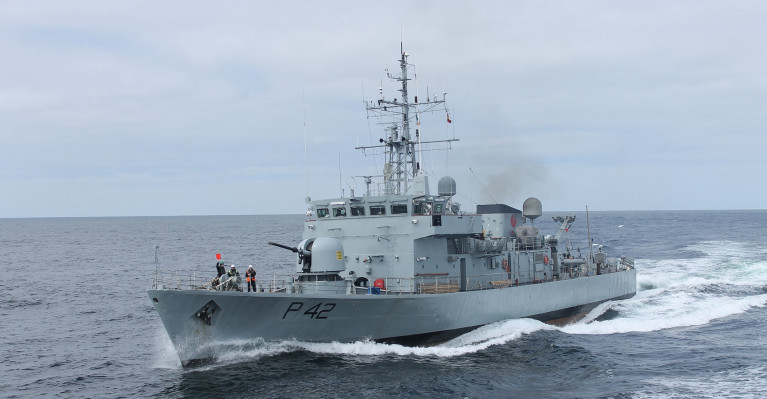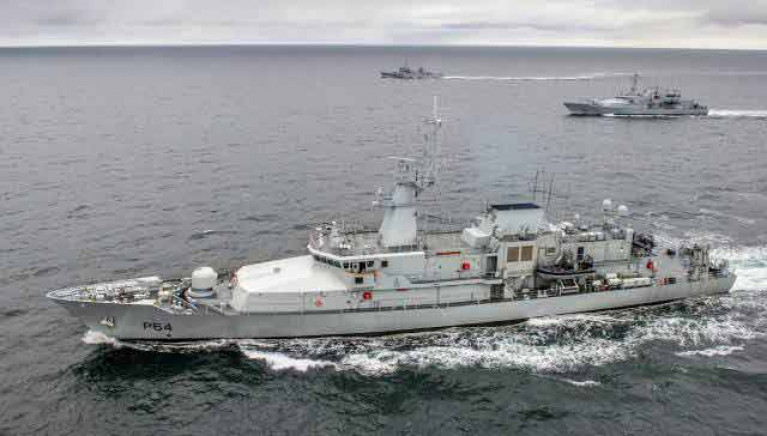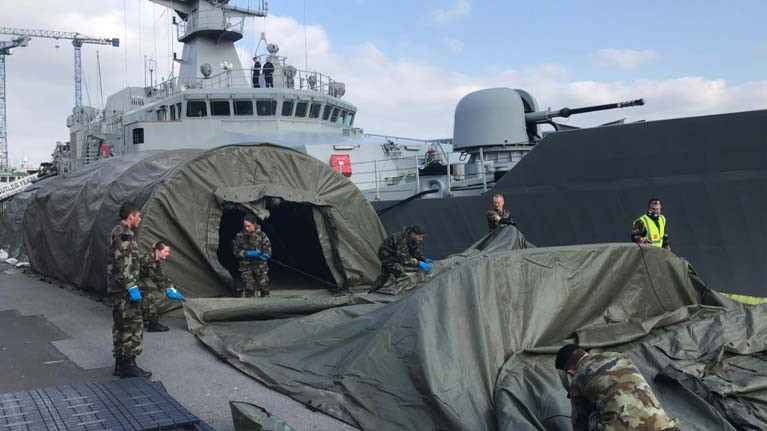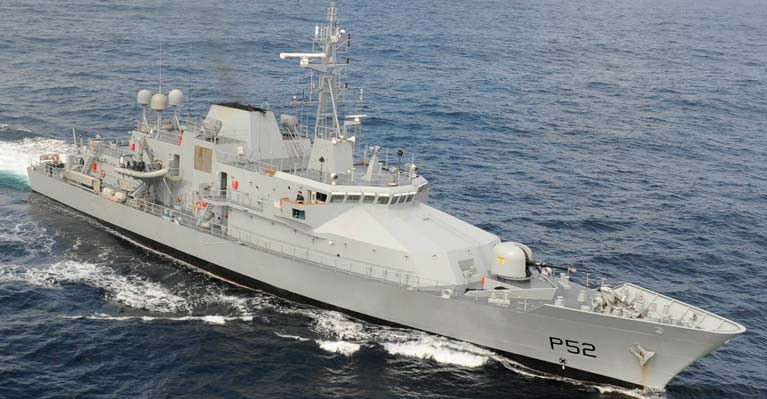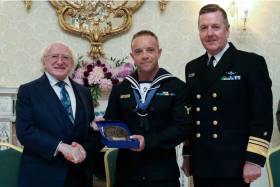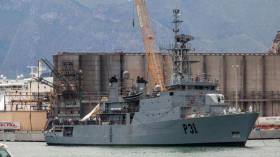Displaying items by tag: Navy
A French registered fishing vessel has been detailed for alleged breaches of fishing regulations by the Naval Service.
The vessel was fishing approximately 120 nautical miles south-west of Mizen Head, Co Cork, last night when it was apprehended by the LÉ Ciara.
The Naval Service said that the vessel was being escorted to Castletownbere Co. Cork, where it would be handed over to An Garda Síochána on arrival.
The detention is the fifth this year by the Naval Service, as part of its service level agreement with the Sea Fishery Protection Authority.
As Afloat previously reported, a French-registered Spanish-owned vessel, Miss Jacqueline, was also detained by the LÉ George Bernard Shaw last month, about 180 nautical miles west of Mizen Head.
Last month, the EU maritime directorate had written to Ireland, questioning how Ireland could meet its legal obligations to control and check fish landings under guidelines related to the Covid-19 pandemic.
Navy Arrests French Fishing Vessel off South-West Coast
A French registered fishing vessel has been detained by the Naval Service off the south-west coast.
The vessel was detained by the LÉ George Bernard Shaw 180 nautical miles west of Mizen Head for an alleged breach of fishing regulations.
The Defence Forces press office said the vessel will be escorted to Castletownbere Co Cork, where it will be handed over to the Garda.
The detention is the fourth vessel apprehended by the Naval Service this year.
The European Commission has written to Ireland this month, asking it to outline it can maintain physical inspections at sea and in port under the Common Fisheries Policy (CFP) regulations in light of the pandemic.
The Defence Forces have said that in spite of the Covid-19 pandemic restrictions and commitments to supply ships for testing centres, sea fishery inspections will continue in line with a service level agreement with the Sea Fishery Protection Authority (SFPA).
The Naval Service patrol ship LÉ James Joyce prepared to depart Galway port at the weekend, as COVID-19 virus test centres in the west were scaled down.
The LE James Joyce berthed in Galway on April 8th, replacing the LÉ William Butler Yeats which set up the first field hospital in Galway for the Health Service Executive last month (march).
It is understood the test facilities at Galway’s dockside were used minimally over the ten days, and the LÉ James Joyce was informed at the weekend that its services were no longer required.
Two other patrol ships are still providing assistance to the HSE – the LÉ Niamh on Sir John Rogerson’s Quay in Dublin, and the LÉ Eithne on Albert Quay in Cork.
Testing is not taking place at the LÉ Eithne, but the ship’s crew has been assisting with storage of personal protection equipment and decanting hand sanitisers.
.Galway had 273 confirmed cases of the COVID-19 virus as of yesterday, an increase of seven over a 24-hour report period.
Both Galway and Mayo are said to be at the lower end of the scale of confirmed cases of the virus.
The HSE has said it is up to date on COVID-19 test referrals, with waiting time for an appointment at under 24 hours.
Paying tribute to all staff involved, it said that community test centres could be stepped up again if required.
Defence Force staff set up a tented field hospital beside the Naval patrol ship, LE William Butler Yeats, yesterday (sun) in preparation for use as a Covid-19 testing centre writes Lorna Siggins
A marquee was erected beside the ship in Galway docks, similar to arrangements made for the Health Service Executive in Dublin and Cork.
The LÉ Samuel Beckett has already been deployed to Dublin and the LÉ Eithne to Cork city, with all three cities having riverside berths.
Naval service experience of testing for infectious illnesses during migrant rescue in the Mediterranean influenced the decision to make ships available as support to the HSE.
The Defence Forces Press Office said the ships were deployed “to generate extra capacity for the HSE.
It has confirmed one ship has been kept for fisheries protection surveillance, but fishing fleets are already beginning to tie up in response to a dramatic slump in seafood demand and closure of international markets.
As thousands of people took to the outdoors in the west yesterday (sun), a drone flying over Galway’s Salthill promenade urged walkers to observe social distancing guidelines to avoid Covid-19 infection.
Fianna Fáil Galway West TD Eamon Ó Cuív expressed concern yesterday (sun) that social distancing was not being observed by visitors to the west coast.
“Disturbing reports from Achill of people travelling to the area, failing to observe social distancing and putting local people at risk. I’ve heard similar reports from Connemara. I would appeal to people-respect local communities and keep your distance-that includes when in shops and outside,”Mr Ó Cuív said in a statement on social media.
The drone flying over Salthill yesterday (sun) relayed a recording urging people to keep two metres apart.
However, the aerial device was not clearly identified, and some walkers were mystified.
Galway City Council said it had not commissioned a drone. Several other State bodies, including the Defence Forces and Civil Defence, also said they had not deployed it.
Drones have been used in China for a range of Covid-19 responses, from warning people to wear masks and observe quarantine curfews to lighting the construction sites for purpose built hospitals after the outbreak late last year.
Spanish police also deployed drones in Madrid to issue public health warnings and appeal to people to return home from public places after a state of emergency was declared.
Galway City Council issued an “urgent” call before the weekend to the public to obey social distancing, and installed stencils on the Promenade depicting two metre distances for walkers.
The Leave No Trace campaign has issued guidelines for walkers, including observing the two-metre distance and avoiding both peak times and difficult routes on uplands. It has also urged walkers to take their rubbish home.
The Naval Service patrol ship LÉ WB Yeats has berthed in Galway for potential use as a testing facility for the Covid-19 virus writes Lorna Siggins
The ship is one of three Naval Service vessels requested for use by the Health Service Executive (HSE), as plans are underway to roll out 34 testing facilities across the State.
The vessel under command of Lieut Cdr Martin Tarrant arrived into Galway docks on Tuesday night and was due to be visited by HSE staff yesterday to conduct a risk assessment.
The LÉ Samuel Beckett has already been deployed to Dublin for similar use, and another ship is on standby in Haulbowline naval base for location in Cork.
Naval Service experience of testing for infectious illnesses during migrant rescue in the Mediterranean influenced the decision to make ships available as support to the HSE.
The Defence Forces Press Office said the ships were deployed “to generate extra capacity for the HSE”, and it was awaiting further instructions.
It is anticipated that arrangements already in place for testing at Dublin’s Croke Park would be simulated, with marquees established onshore and the ships providing logistical support. All three cities have riverside berths which offers ease of access.
The HSE has emphasised that people should not present at the various centres without a scheduled appointment, following referral by GPs if necessary after an initial assessment by phone.
.Those suffering from symptoms of Covid-19 (typically dry cough and fever) should ring their GP who will arrange a test if deemed necessary.
The LE WB Yeats was commissioned in 2016, first deployed to the Mediterranean in 2017, and is twinned with Galway city.
Galway harbourmaster Capt Brian Sheridan said that the move further emphasised the critical role of ports in providing a response to the current situation.
He confirmed that he and his port pilots and other key staff will be seeking early tests for the virus, being among a group of Port of Galway staff who are key to ensuring supply chains are kept open.
Already, a number of measures have been taken by ports including Galway to comply with World Health Organisation control guidelines for Covid-19 at sea. Capt Sheridan confirmed that one of the measures includes cancelling all shore leave for visiting ships.
Vessels have been asked to supply certification of medical compliance before berthing, and to ensure all areas onboard are thoroughly sanitised.
Communication with pilots who have to board vessels to provide navigation into port must also comply with social distancing measures, he said.
“These measures apply to all our staff – port pilots and crew who have to board ships, dock gatemen, crane drivers – and Port of Galway staff who can work from home are doing so,” Capt Sheridan said.
Shipping schedules will continue as normal, he said. The Port of Galway has also offered a ten-acre property in the city to the HSE for the location of field hospital facilities if required, he said.
Weather Forces Change of Venue from Ship to Shore for Sunrise Musical Performance as Part of Galway 2020
Near gale force and gusty south-west winds have forced a change of venue for a Galway 2020 International Women’s Day event on board the Naval Service patrol ship LÉ Niamh on Sunday morning.
The patrol ship was to have hosted “Ragadawn”, an outdoor sunrise performance by international poet and sound artist Caroline Bergvall.
However, due to the potential impact of the wind on the sound systems, the sell-out event will now take place in the Druid Theatre, Galway at 7 am on Sunday, March 8 th – within walking distance of the ship at Galway docks.
LÉ Niamh arrived into Galway under the command of Lieut Cdr Claire Murphy on Thursday in preparation for international women’s day.
It is almost 12 years since Lieut Cdr Roberta O’Brien became the first female commander of a navy patrol vessel – the LÉ Aisling - and that handover ceremony took place in Galway, the city which the ship had been twinned with.
Galway 2020 cultural producer Liz Kelly has paid tribute to the Naval Service and Galway harbourmaster Capt Brian Sheridan for agreeing to participate in the event.
“Ragadawn” is described as a unique outdoor sunrise performance by international poet and sound artist Caroline Bergvall.
It comprises a “multisensory composition for two live voices, a dawn chorus of multiple recorded languages, alongside a special vocal work for soprano by Gavin Bryars”, and it “invites audiences to follow the slow rising of day”.
The composition draws on “ancient and contemporary musical and literary sunrise traditions”, with “breath patterns, poetic voice, song, languages, electronic frequencies and passing sounds”
It aims to recall “the cyclical patterns that connect all beings both to nature and society, and the awakening of mind and body”, and is described as “a powerful and moving voice performance that reconnects audiences to time, place and to each other”.
The event is one of a number programmed by Galway 2020 over this weekend to mark international women’s day.
Spanish Registered Fishing Vessel Detained off Kerry Coast
A Spanish registered fishing vessel has been escorted into Galway by the Naval Service after it was detained off the Kerry coast writes Lorna Siggins.
The vessel was inspected by the Naval Service patrol ship LÉ William Butler Yeats and detained about 59 nautical miles north-west of Valentia Island, Co Kerry, on Friday, November 15 for alleged breach of fishing regulations.
It was handed over to the Garda on berthing in Galway harbour. It is the 12th fishing vessel detained so far by the Naval Service this year.
Navy Diver on Migrant Rescue Among Seven Recipients of Defence Forces Value Awards
A Naval Service diver who was involved in migrant rescue in the Mediterranean is one of seven recipients of Defence Forces value awards conferred by President Michael D Higgins on Wednesday evening writes Lorna Siggins
Able Mechanician Ryan O’Driscoll, originally from Rush, Co Dublin, and a Naval Service diver for the past three years, was also involved in the recovery operation after the loss of four Irish Coast Guard air crew in the Rescue 116 crash off north Mayo over two years ago.
The Defence Force value awards aim to celebrate outstanding service, and acknowledge the support and encouragement of the families of the recipients.
Also awarded were Corporal Caitriona Lacey, Gunner David Stack, Corporal David McCormack, Private Thomas Carew, Sergeant PJ McCabe and Regimental Sergeant Major John Murray.
Able Mechanician O’Driscoll served on the Naval Service ship LE Samuel Beckett in the Mediterranean during Ireland’s participation in Operation Pontus, a bilateral rescue initiative with Italy, and the now-suspended EUNAVFOR Med Operation Sophia.
As a diver, he participated in many missions in Irish waters and was directly involved in the recovery of the body of Irish Coast Guard co-pilot Capt Mark Duffy from the wreckage of the R116 helicopter off Blackrock island in north Mayo in March, 2017.
He was described in his citation as being a natural leader who has the respect of his peers.
Private Thomas Carew Private Thomas Carew, from Ferrybank in Waterford, was awarded for his “commendable selflessness” in saving the life of a civilian motorcyclist in a road accident in which he was propelled by the impact of the collision into an estuary in high tide.
Private Carew, from the Army’s 3rd Infantry Battalion, was nominated by a former superior.
Cpl David McCormack from Galway, was nominated by many of his comrades from the 1st Infantry Battalion for his response to an assault which left him with life-threatening injuries after he had returned from overseas service with the UN.
Cpl Catriona Lacey from Athlone, Co Westmeath, was nominated by fellow soldiers in 6th Infantry Battalion, having demonstrated moral courage after the loss of her brother, Thomas, to suicide in 2014.
Her father, Frank served 31 years in the Defence Forces brass band as a bugler and played at former president Eamon De Valera’s funeral. He is retired 20 years.
President Higgins said he was pleased to have been asked by Vice-Admiral Mark Mellett, head of the Defence Forces, to facilitate the event and “to celebrate the outstanding service given by seven deserving awardees”.
“ I am so pleased to have the opportunity of acknowledging in general, the support given by the families of so many members of our defence forces – a support that makes the contribution of their partners possible,” Mr Higgins said.
“You have all displayed a magnanimous resolve and steadfast commitment to uphold the central values of the Defence Forces, and your individual efforts and service to Ireland are being highlighted in this ceremony today,” Mr Higgins said.
A Naval Service ship on Mediterranean rescue several years ago was unable to recover a migrant’s body that it had located in the water for several hours until it could confirm which EU state would accept it, a former mission member has recalled writes Lorna Siggins
The crew of the LÉ Samuel Beckett stood by for a total of four hours until eventually, the Maltese authorities agreed, Able Seaman Ian Trimble, a Naval Service diver, has said.
During that time, four EU coastal states in all had been contacted by the ship, he said, but the situation was complicated by the fact that the body was in international waters,
The harrowing experience was one of several recounted by the Naval Service crew, led by Commander Anthony Geraghty, at a Galway International Arts festival “First Thought” talk convened by Caitriona Crowe and chaired by Judy Murphy.
The LÉ Samuel Beckett (italics) was deployed on several missions during Ireland’s deployment of ships on migrant rescue between 2015 and 2018, when almost 18,000 people were rescued, two babies were delivered and 86 bodies were recovered by 11 Irish ships in all.
EU maritime missions were suspended earlier this year, after Italy’s far-right government refused to continue to accept migrants, but aerial reconnaissance continues. Up to 700 people are reported to have drowned this year so far, according to International Organisation for Migration figures, with an estimated 150 dying last week.
Commander Geraghty, who said he would return if Ireland’s assistance was sought as part of a resumed EU effort, described how he could never understand how anybody would get into a vessel with no lifejackets and no flares.
He said he could only conclude that the lives of migrants at home was “so bad that no matter what happens to them, it’s worth it” when risking a crossing at sea.
In his 29 years with the Naval Service, his three-month mission in the Mediterranean had been “the most fulfilling”, he said.
The barges crowded with between 250 and 800 migrants which the Naval Service came across were particularly challenging, as the crew would know that for every person on the top deck there would be many people locked below, Geraghty said.
If the barge capsized, as it regularly did, those locked below in the hold would drown.
Medical sick berth attendant Seán Doyle said most of the injuries he treated were chemical burns from fuel, along with dehydration and exhaustion.
“I don’t think anything really prepared us...I saw things I wouldn’t want to see, and wouldn’t want anyone else to see,”Petty Officer Trish O’Sullivan, an electrician, said.
O’Sullivan, who served on two Mediterranean missions in 2015 and 2016, said that “military rank goes out the window” during a rescue.
“When you are trying to get everyone on board, safety is paramount,” she said, adding that she did between 700 and 800 squats one day while searching people who were being taken on board ship.
While she recovered several nails and blades, most people carried photos, family albums, heirlooms, and food.
“There might be a drawing their daughter had made...and their clothes would be covered in petrol and faeces, “she said.
Some had little or no clothing and “we tried to protect people’s dignity,” O’Sullivan said.
The four LÉ Samuel Beckett crew showed an excerpt from the documentary, The Crossing, directed by Judy Kelly, which was filmed onboard the ship during its first Mediterranean deployment and broadcast in 2016.
The LÉ Samuel Beckett was deployed in 2016 under a bilateral agreement with Italy, Operation Pontus, and latterly in 2018 under the EU NavFOR Med Operation Sophia which was primarily focused on security and disrupting smuggler activity, and on rescue.
Some 600 Naval Service crew, including 40 medical staff with some Army and Air Corps participants, served on the 11 missions, which were an average of three months in duration, and involved an additional tax-free allowance of about €70 a day while aboard.
Last week, non-governmental organisation Medecins Sans Frontieres (MSF) confirmed that it was resuming its rescue operations in the central Mediterranean.
The decision was taken after what the NGO said was a “two-year campaign by virtually all EU governments to stop humanitarian action at sea”.
MSF has also condemned the recent return of migrants, caught at sea by the Libyan Coast guard, to the Libyan Tajoura detention centre which was bombed in July, killing 60 people and injuring many others.
Plans for €200m Navy Ship May be Stalled
The Government may delay plans for a 200 million euro “multi-role” Naval Service ship, amid continuing controversy over crewing shortages for the existing fleet writes Lorna Siggins
A joint civil-military meeting is due to take place today at the direction of Minister of State for Defence Paul Kehoe, which will focus on “Naval Service capability and operations” according to his department.
Mr Kehoe has asked his officials and military representatives to “fully explore all options to address the challenges in the Naval Service” at the end of a fortnight during which Mr Kehoe and Taoiseach Leo Varadkar differed initially over why three ships are tied up.
Commodore Malone stated in a Defence Force newsletter in June that 540 personnel had left the service in the past five years, and he had decided “to place two ships in an operational reserve capacity” due to the staff shortages.
These two ships, the LÉ Eithne and LÉ Orla, are still in “operational reserve”, according to the department, while the LÉ Roisín is tied up for a mid-term refit.
Government policy is to maintain a nine-ship fleet – the largest ever in defence wing’s history – and the department says the Naval Service has 88 per cent of its establishment, as in 996 staff as of May 31st this year, compared to an establishment figure of 1,094 staff.
Ordering a new multi-role vessel to replace the flagship, LÉ Eithne is provided for in the Government’s White Paper on Defence as part of a commitment to “ongoing renewal and replacement of naval vessels”, the department says.
The new vessel is a “very significant project”, the department says, but it is still “at the planning stage”.
“Accordingly, no public procurement competition tender documentation has issued to the market at this stage,” the department says.
“ As a longer-term project, it will involve a number of years to completion,” it says.
Minister Kehoe “has a particular focus at present on restoring the Naval Service to full personnel strength”, the department says.
During a Dáíl debate last month (June 13th) on defence forces remuneration, Mr Kehoe said it was “important that we continue to invest in training and equipment” in the military.
During the debate, former Independent TD Mick Wallace referred to National Development Plan capital investment of 541 million euro in defence between 2018-2022 and accused Mr Kehoe of “throwing money at things like new ships for the Naval Service”
A 200 million euro multi-role vessel has “less to do with the Naval Service being able to fulfil its day-to-day duties and much more to do with trying to impress our European colleagues in the Mediterranean”, Mr Wallace said during the debate.
“The multi-role vessel will be capable of carrying a battalion of soldiers along with landing craft. It will also have freight capacity for military vehicles. What in God's name do we need that for? The Minister of State would be better off paying the Defence Forces personnel,” Mr Wallace continued.
On October 3rd, 2018 Independent TD Seamus Healy called on Mr Kehoe to “scrap” plans for the multi-role vessel in the light of the “current position on pay and conditions of employment in the defence forces.
“I do not believe we should scrap the project,” Mr Kehoe responded to Mr Healy.” This is a commitment from the Government. We will continue until tendering stage.”
“ When we get to that stage we will look at the resource envelope available to the Defence Forces. I make no apologies for equipping members of the Defence Forces with the very best equipment,” Mr Kehoe said last October.


























